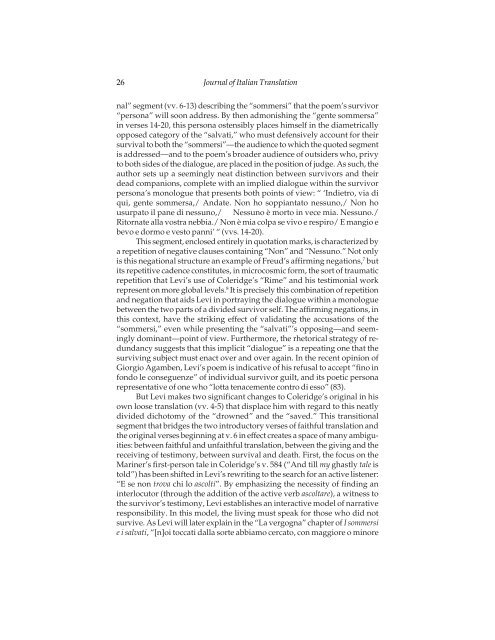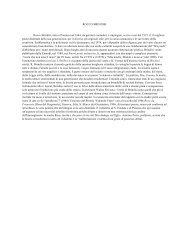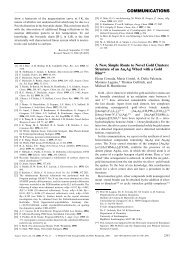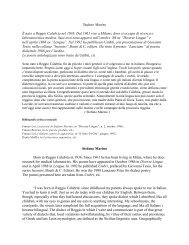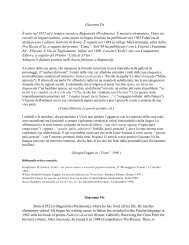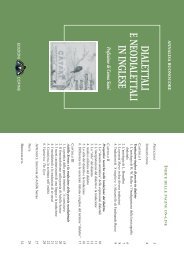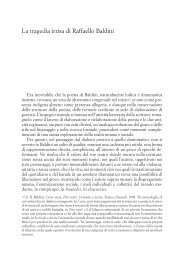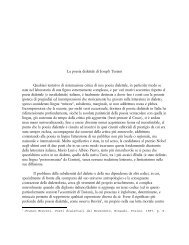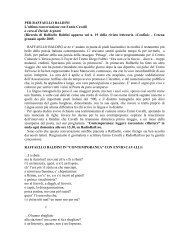Journal of Italian Translation
Journal of Italian Translation
Journal of Italian Translation
Create successful ePaper yourself
Turn your PDF publications into a flip-book with our unique Google optimized e-Paper software.
26 <strong>Journal</strong> <strong>of</strong> <strong>Italian</strong> <strong>Translation</strong><br />
nal” segment (vv. 6-13) describing the “sommersi” that the poem’s survivor<br />
“persona” will soon address. By then admonishing the “gente sommersa”<br />
in verses 14-20, this persona ostensibly places himself in the diametrically<br />
opposed category <strong>of</strong> the “salvati,” who must defensively account for their<br />
survival to both the “sommersi”—the audience to which the quoted segment<br />
is addressed—and to the poem’s broader audience <strong>of</strong> outsiders who, privy<br />
to both sides <strong>of</strong> the dialogue, are placed in the position <strong>of</strong> judge. As such, the<br />
author sets up a seemingly neat distinction between survivors and their<br />
dead companions, complete with an implied dialogue within the survivor<br />
persona’s monologue that presents both points <strong>of</strong> view: “ ‘Indietro, via di<br />
qui, gente sommersa,/ Andate. Non ho soppiantato nessuno,/ Non ho<br />
usurpato il pane di nessuno,/ Nessuno è morto in vece mia. Nessuno./<br />
Ritornate alla vostra nebbia./ Non è mia colpa se vivo e respiro/ E mangio e<br />
bevo e dormo e vesto panni’ “ (vvs. 14-20).<br />
This segment, enclosed entirely in quotation marks, is characterized by<br />
a repetition <strong>of</strong> negative clauses containing “Non” and “Nessuno.” Not only<br />
is this negational structure an example <strong>of</strong> Freud’s affirming negations, 7 but<br />
its repetitive cadence constitutes, in microcosmic form, the sort <strong>of</strong> traumatic<br />
repetition that Levi’s use <strong>of</strong> Coleridge’s “Rime” and his testimonial work<br />
represent on more global levels. 8 It is precisely this combination <strong>of</strong> repetition<br />
and negation that aids Levi in portraying the dialogue within a monologue<br />
between the two parts <strong>of</strong> a divided survivor self. The affirming negations, in<br />
this context, have the striking effect <strong>of</strong> validating the accusations <strong>of</strong> the<br />
“sommersi,” even while presenting the “salvati”’s opposing—and seemingly<br />
dominant—point <strong>of</strong> view. Furthermore, the rhetorical strategy <strong>of</strong> redundancy<br />
suggests that this implicit “dialogue” is a repeating one that the<br />
surviving subject must enact over and over again. In the recent opinion <strong>of</strong><br />
Giorgio Agamben, Levi’s poem is indicative <strong>of</strong> his refusal to accept “fino in<br />
fondo le conseguenze” <strong>of</strong> individual survivor guilt, and its poetic persona<br />
representative <strong>of</strong> one who “lotta tenacemente contro di esso” (83).<br />
But Levi makes two significant changes to Coleridge’s original in his<br />
own loose translation (vv. 4-5) that displace him with regard to this neatly<br />
divided dichotomy <strong>of</strong> the “drowned” and the “saved.” This transitional<br />
segment that bridges the two introductory verses <strong>of</strong> faithful translation and<br />
the original verses beginning at v. 6 in effect creates a space <strong>of</strong> many ambiguities:<br />
between faithful and unfaithful translation, between the giving and the<br />
receiving <strong>of</strong> testimony, between survival and death. First, the focus on the<br />
Mariner’s first-person tale in Coleridge’s v. 584 (“And till my ghastly tale is<br />
told”) has been shifted in Levi’s rewriting to the search for an active listener:<br />
“E se non trova chi lo ascolti”. By emphasizing the necessity <strong>of</strong> finding an<br />
interlocutor (through the addition <strong>of</strong> the active verb ascoltare), a witness to<br />
the survivor’s testimony, Levi establishes an interactive model <strong>of</strong> narrative<br />
responsibility. In this model, the living must speak for those who did not<br />
survive. As Levi will later explain in the “La vergogna” chapter <strong>of</strong> I sommersi<br />
e i salvati, “[n]oi toccati dalla sorte abbiamo cercato, con maggiore o minore


